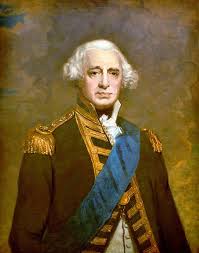Annotation:Admiral Howe’s March: Difference between revisions
No edit summary |
m (Text replacement - "garamond, serif" to "sans-serif") |
||
| Line 1: | Line 1: | ||
=='''Back to [[{{BASEPAGENAME}}]]'''== | =='''Back to [[{{BASEPAGENAME}}]]'''== | ||
---- | ---- | ||
<p><font face=" | <p><font face="sans-serif" size="4"> | ||
'''ADMIRAL HOWE'S MARCH'''. English, March (whole time). C Major. Standard tuning (fiddle). AABB. 'Admiral Howe' was Richard Howe [http://en.wikipedia.org/wiki/Richard_Howe,_1st_Earl_Howe], 1st Earl Howe (1726-1799), who commanded the naval forces for Britain during the War of American Indepndance, and who also served on the peace commission at the end of the conflict. It was Adiral Howe who was in command of the British fleet during the victory at the Glorious First of June in 1794, against the ships of the First French Republic. | '''ADMIRAL HOWE'S MARCH'''. English, March (whole time). C Major. Standard tuning (fiddle). AABB. 'Admiral Howe' was Richard Howe [http://en.wikipedia.org/wiki/Richard_Howe,_1st_Earl_Howe], 1st Earl Howe (1726-1799), who commanded the naval forces for Britain during the War of American Indepndance, and who also served on the peace commission at the end of the conflict. It was Adiral Howe who was in command of the British fleet during the victory at the Glorious First of June in 1794, against the ships of the First French Republic. | ||
[[File:richardhowe.jpg|300px|thumb|left|Admiral Richard Howe]] | [[File:richardhowe.jpg|300px|thumb|left|Admiral Richard Howe]] | ||
| Line 10: | Line 10: | ||
<br> | <br> | ||
</font></p> | </font></p> | ||
<p><font face=" | <p><font face="sans-serif" size="4"> | ||
''Source for notated version'': | ''Source for notated version'': | ||
<br> | <br> | ||
<br> | <br> | ||
</font></p> | </font></p> | ||
<p><font face=" | <p><font face="sans-serif" size="4"> | ||
''Printed sources'': Aird ('''Selection of Scotch, English, Irish and Foreign Airs, vol. 5'''), | ''Printed sources'': Aird ('''Selection of Scotch, English, Irish and Foreign Airs, vol. 5'''), | ||
Glasgow, 1797; No. 74, p. 30. | Glasgow, 1797; No. 74, p. 30. | ||
| Line 21: | Line 21: | ||
<br> | <br> | ||
</font></p> | </font></p> | ||
<p><font face=" | <p><font face="sans-serif" size="4"> | ||
''Recorded sources'': <font color=teal></font> | ''Recorded sources'': <font color=teal></font> | ||
</font></p> | </font></p> | ||
Revision as of 10:59, 6 May 2019
Back to Admiral Howe’s March
ADMIRAL HOWE'S MARCH. English, March (whole time). C Major. Standard tuning (fiddle). AABB. 'Admiral Howe' was Richard Howe [1], 1st Earl Howe (1726-1799), who commanded the naval forces for Britain during the War of American Indepndance, and who also served on the peace commission at the end of the conflict. It was Adiral Howe who was in command of the British fleet during the victory at the Glorious First of June in 1794, against the ships of the First French Republic.

The melody was also entered into the c. 1780-1804 music manuscript collection of fifer or fiddler John Fife, who may have been from Perthshire, and may also have made entries at sea (there are references to battles in the Caribbean and the Mediterranean). It was also entered (along with a number of tunes from Aird's 5th collection) into the large 1840 music manuscript collection of multi-instrumentalist John Rook, of Waverton, near Wigton, Cumbria.
Source for notated version:
Printed sources: Aird (Selection of Scotch, English, Irish and Foreign Airs, vol. 5),
Glasgow, 1797; No. 74, p. 30.
Recorded sources:
